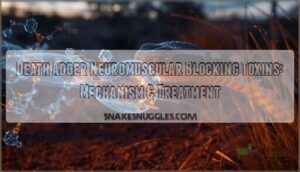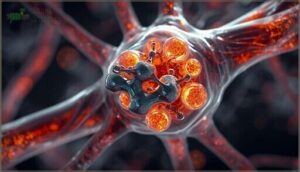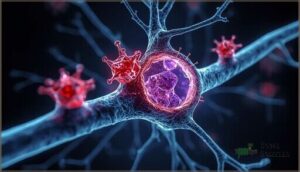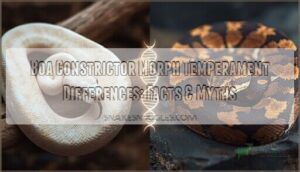This site is supported by our readers. We may earn a commission, at no cost to you, if you purchase through links.

A single bite from Australia’s death adder can deliver neurotoxins so potent that they shut down your neuromuscular junction within hours, leaving you paralyzed and unable to breathe. These death adder neuromuscular blocking toxins don’t simply interfere with nerve signals—they orchestrate a dual assault on both sides of the synaptic cleft, binding irreversibly to nerve terminals while simultaneously blocking muscle receptors.
What makes these toxins particularly dangerous is their resistance to standard treatments: even modern antivenoms struggle to reverse the blockade once it’s established. Understanding how these molecular weapons dismantle your body’s communication system reveals why death adder bites demand immediate medical intervention and why supportive care often becomes the difference between recovery and respiratory failure.
Table Of Contents
- Key Takeaways
- Death Adder Venom Composition and Neurotoxins
- Mechanism of Neuromuscular Blockade
- Frequently Asked Questions (FAQs)
- Which snake venom is responsible for neurotoxicity?
- How does death adder venom work?
- Are adders neurotoxic?
- What does snake venom do to the neuromuscular junction?
- Does snake venom contain paralyzing toxins?
- How dangerous is a death adder snake bite?
- What are the chances of survival?
- What does death adder venom do to the body?
- How does antivenom work to counter the venom?
- What should I do if bitten by a death adder?
- Conclusion
Key Takeaways
- Death adder venom delivers a dual neurotoxic assault by binding irreversibly to nerve terminals while simultaneously blocking muscle receptors, creating a pseudo-irreversible paralysis that standard antivenoms struggle to reverse once established.
- The venom’s heterotrimeric phospholipase A2 complexes cause presynaptic damage that persists 48-72 hours and requires nerve regeneration for recovery, making early mechanical ventilation critical since antivenom can’t restore function already lost.
- Neurotoxic symptoms typically appear within 4 hours and follow a descending paralysis pattern starting with ptosis and diplopia, progressing to respiratory failure if untreated—yet with prompt pressure immobilization and antivenom, modern survival rates approach near-zero mortality.
- The presynaptic toxins’ enzymatic destruction of nerve terminals distinguishes death adder envenomation from other snakebites, explaining why supportive care and mechanical ventilation often matter more than antivenom alone in preventing fatal respiratory collapse.
Death Adder Venom Composition and Neurotoxins
Death adder venom isn’t a single toxin—it’s a carefully orchestrated cocktail of molecules designed to overwhelm your neuromuscular system. Understanding what’s actually in this venom helps explain why paralysis happens so quickly and why treatment remains challenging.
Let’s break down the key components that make death adder envenoming so distinctly neurotoxic.
Post-synaptic Neurotoxins and Acantoxin IVa
Among death adder’s arsenal, post-synaptic neurotoxins like acantoxin IVa—a 6815 Da three-finger toxin—deliver muscle paralysis by targeting nicotinic acetylcholine receptors. Here’s what makes these αneurotoxins so potent:
- High receptor affinity with nanomolar binding strength (pA2 ~8.36)
- Pseudo-irreversible antagonism that prolongs neuromuscular blockade
- Selective muscle receptor targeting over neuronal subtypes
- Toxin binding at orthosteric sites, blocking acetylcholine access
- Neurotoxin structure stability via disulfide bridges ensures lasting effects
Understanding the neuromuscular transmission process is essential for developing effective treatments.
Antivenom can neutralize circulating toxins but won’t reverse established neurotoxicity.
Pre-synaptic Phospholipase A2 Neurotoxins
While post-synaptic toxins grab receptors, presynaptic neurotoxins attack nerve terminals themselves. Death adder venom contains phospholipase A2 (PLA2) enzymes—monomeric proteins around 13,000 Daltons—that dismantle nerve cell membranes through a phospholipase mechanism. Toxin binding triggers vesicle fusion, followed by the complete drainage of acetylcholine stores, resulting in a neuromuscular blockade that antivenom cannot reverse once established. The venom’s potency is due to its presynaptic toxin properties.
| PLA2 Feature | Clinical Impact |
|---|---|
| Enzyme activity at nerve terminals | Progressive neuromuscular damage |
| IC50 of 0.19 μM | Concentration-dependent paralysis |
| Pseudo-irreversible action | Prolonged neurotoxicity despite treatment |
Heterotrimeric Neurotoxin Complexes
You’ll find the most devastating neurotoxin structure in death adder venom isn’t a single molecule—it’s a three-part weapon. The heterotrimeric complex P-EPTX-Aa1a combines α, β, and γ subunits in equal ratios, with molecular weights between 22 and 66 kDa.
Only the α-chain delivers neurotoxicity through phospholipase A2 activity, creating a presynaptic neuromuscular blockade that antivenom can’t reverse once these molecular interactions establish toxin binding at nerve terminals.
Only the α-chain delivers neurotoxicity through phospholipase A2, creating a presynaptic blockade that antivenom cannot reverse once toxin binding occurs
Additional Venom Components and Their Roles
Beyond the neurotoxic arsenal, death adder venom contains phospholipase A2 enzymes at 10–50 μg/ml that contribute to myotoxin effects through direct muscle damage. You’ll notice L-amino acid oxidase activity and mild anticoagulant properties, though coagulant activities remain clinically insignificant—no procoagulant coagulopathy has been documented.
This enzymatic complexity explains variable clinical presentations, including elevated CK levels and local myalgia, complicating the neuromuscular block picture antivenom attempts to address.
Comparative Potency Among Australian Elapid Venoms
You’ll find inland taipan venom holds the title as Australia’s most potent neurotoxin—a mere 0.025 mg/kg LD50 dwarfs death adder’s ranking.
Despite death adder’s 60% three-finger toxin dominance, coastal taipan’s 16% presynaptic fraction outpaces its 6% concentration.
This elapid species diversity in neurotoxin evolution and venom potency comparison reveals why antivenom dosing varies dramatically: death adder requires 6,000 units versus brown snake’s 1,000.
Mechanism of Neuromuscular Blockade
Death adder venom disrupts the communication between your nerves and muscles in ways that make it particularly dangerous. The toxins don’t just attack one target—they work at multiple sites along the neuromuscular junction, creating a compound effect that leads to paralysis.
Understanding how these mechanisms unfold helps explain why treatment remains challenging and why symptoms develop in their characteristic pattern.
Post-synaptic Blockade of Nicotinic Acetylcholine Receptors
When death adder neurotoxins reach your neuromuscular junction, they lock onto nicotinic receptors like a key jamming a lock. This receptor binding prevents acetylcholine inhibition, blocking muscle activation entirely.
The neurotoxin structure—particularly acantoxin IVa’s three-finger fold—facilitates pseudo-irreversible antagonism, causing muscle paralysis that persists even after antivenom clears circulating toxins. Anticholinesterase therapy can’t dislodge these tightly bound neurotoxins, leaving you vulnerable to prolonged neurotoxicity.
Pre-synaptic Inhibition of Acetylcholine Release
While post-synaptic toxins jam your muscle receptors, presynaptic neurotoxins stage a more devastating assault—they cut off the signal at its source. These presynaptic phospholipase A2 complexes irreversibly bind to nerve terminals, shutting down acetylcholine release at the neuromuscular junction. The presynaptic mechanism creates neurotoxicity that resists reversal:
- Neurotoxin binding blocks acetylcholine exocytosis
- Suppression reaches 40–50% of maximal responses
- Acetylcholine blockade persists despite anticholinesterase therapy
- Neuromuscular failure becomes therapeutically irreversible
This toxin resistance explains why you’ll face prolonged paralysis regardless of treatment timing.
Pseudo-irreversible Antagonism at The Neuromuscular Junction
You’re facing a unique type of neuromuscular block when death adder neurotoxins strike—it’s called pseudo-irreversible antagonism. These toxins bind to your skeletal muscle nicotinic acetylcholine receptors with remarkable toxin affinity (pA2 values exceeding 8.0), creating receptor binding that won’t let go.
Once attached at the neuromuscular junction, these neuromuscular blocking agents dissociate incredibly slowly, producing a neuromuscular blockade that persists for hours despite anticholinesterase therapy. This fundamentally disrupts neuromuscular transmission through their antagonist mechanism.
Concentration-dependent Effects on Muscle Contraction
When you’re exposed to higher concentrations of death adder venom, you’ll experience a dose response that dramatically amplifies neuromuscular blockade. Here’s what venom potency does to muscle contraction:
- At 3–10 μg/ml, partial inhibition occurs with preserved muscle paralysis capability
- Complete neurotoxicity emerges at 10–20 μg/ml, blocking twitches within 9–12 minutes
- Above 20 μg/ml triggers persistent contracture and severe neuromuscular blockade
- Toxin binding affinity increases dramatically, making neurotoxins virtually irreversible
Duration and Reversibility of Blockade
Once neuromuscular blockade sets in, you’re facing two distinct timelines. Post-synaptic neurotoxins produce pseudo-irreversible antagonism lasting 12–24 hours, while pre-synaptic phospholipase A2s cause paralysis extending 48–72 hours. Here’s what determines blockade recovery:
| Toxin Type | Paralysis Duration | Reversal Mechanisms | Toxin Elimination | Neurotoxin Binding |
|---|---|---|---|---|
| Post-synaptic | 12–24 hours | Partial with early antivenom | Rapid neutralization | Receptor-level antagonism |
| Pre-synaptic | 48–72 hours | Minimal reversal | Requires nerve regeneration | Irreversible terminal damage |
| Mixed venom | 24–48 hours | Limited effectiveness | Variable clearance | Dual mechanism blockade |
| Severe cases | >72 hours | Supportive care only | Delayed recovery | Extensive neurotoxicity |
| Early treatment | 4770 U/L in documented cases), focus on analgesia and wound monitoring. Local wound care prevents bite site infection—watch for cellulitis, which developed in four patients and required antibiotics. Two needed surgical intervention for complications like flexor sheath synovitis. |
While antivenom binds circulating toxins, it won’t reverse established myotoxicity. Neuromuscular blockade and envenoming patterns dictate supportive strategies beyond toxicology protocols.
Time Course of Recovery and Prognosis
Recovery patterns after death adder envenomation unfold predictably, helping you anticipate outcomes and plan care:
- Neurotoxic onset usually appears within 4 hours (range: 0.5–15.5 hours)
- Symptom duration averages 21 hours post-antivenom (range: 5–168 hours)
- Neuromuscular weakness resolves completely in 85–95% of patients
- Patient outcomes depend on age, comorbidities, and care delays
- Prognostic factors include absence of symptoms at 12 hours predicting mild envenomation
Most achieve full recovery within one month.
Frequently Asked Questions (FAQs)
Which snake venom is responsible for neurotoxicity?
Like a swift strike to the nervous system, elapid neurotoxins from cobras, kraits, mambas, and death adders drive most neurotoxic envenomation worldwide, triggering paralysis patterns through irreversible blockade and post-synaptic mechanisms.
How does death adder venom work?
Death adder venom works through neurotoxins targeting the neuromuscular junction. Presynaptic neurotoxins in snake venom block acetylcholine release, while post-synaptic toxins bind receptors, causing irreversible antagonism and progressive paralysis.
This paralysis results from receptor blockade and toxin interactions.
Are adders neurotoxic?
Think of neurotoxic snakes as nature’s paralytics. Death adder envenoming demonstrates profound neurotoxicity—86% of bite victims develop muscle paralysis starting with ptosis, confirming these snakes deliver potent neuromuscular blocking toxins requiring immediate medical intervention.
What does snake venom do to the neuromuscular junction?
Snake venom neurotoxins attack the neuromuscular junction through two mechanisms: presynaptic neurotoxins impair acetylcholine release from nerve terminals, while postsynaptic toxins block receptor sites, causing neuromuscular blockade and progressive paralysis.
Does snake venom contain paralyzing toxins?
Consider the ancient fear of serpents—it’s well-founded.
Yes, snake venom contains paralyzing toxins called neurotoxins. These toxins disrupt nerve-muscle communication, causing progressive muscle paralysis that can escalate to respiratory failure.
How dangerous is a death adder snake bite?
Without treatment, you’re facing mortality rates of 50-60%.
A death adder bite carries significant danger—venom yield averages 85 mg, enough to trigger rapid neurotoxic effects, muscle paralysis, and potentially fatal respiratory failure within hours.
What are the chances of survival?
Will you make it through a death adder bite? With prompt snakebite treatment and antivenom access, your survival odds are excellent—modern envenoming cases see near-zero mortality, though neurotoxicity recovery timelines vary considerably based on treatment access and risk factors.
What does death adder venom do to the body?
Death adder venom attacks your nervous system through powerful neurotoxins. You’ll experience descending paralysis, starting with drooping eyelids, then double vision, swallowing difficulty, and potentially respiratory failure requiring ventilation within hours.
How does antivenom work to counter the venom?
When you receive antivenom, it binds to free toxins circulating in your bloodstream, forming immune complexes that your body’s reticuloendothelial system removes—neutralizing venom before it reaches nerve terminals and causes irreversible neurotoxicity.
What should I do if bitten by a death adder?
If you’re bitten, apply pressure bandaging with immobilization immediately, then call emergency services.
Don’t wash the bite site or attempt snake identification yourself—describe it to medical personnel for proper antivenom selection and hospital transport.
Conclusion
Think of death adder neuromuscular blocking toxins as the foremost biological firewall—once they breach your system, they don’t just disrupt communication, they commandeer it entirely.
Your survival hinges on recognizing the early warning signs and securing mechanical ventilation before paralysis advances. Antivenom can neutralize circulating toxins, but it won’t restore function already lost.
When confronting these ancient molecular weapons, speed and supportive care become your most reliable defenses against respiratory failure.











